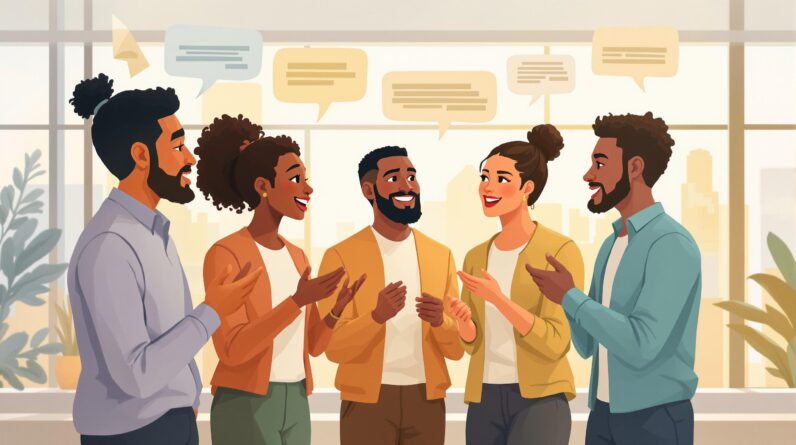
NLP rapport building is about creating trust and understanding through techniques like mirroring, pacing, and non-verbal cues. These methods help improve communication in both personal and professional settings. Here’s a quick summary:
- Mirroring & Matching: Subtly reflect someone’s posture, gestures, tone, and pace to create harmony.
- Pacing & Leading: Match someone’s emotional state and communication style before gently guiding the conversation.
- Non-Verbal Cues: Use body language, facial expressions, and eye contact to build connection naturally.
Practice Tips:
- Start in low-pressure environments like coffee shops or casual chats.
- Use exercises like matching speech patterns or mirroring gestures.
- Adjust techniques based on the setting (e.g., professional vs. casual).
These simple strategies, when practiced regularly, can make your interactions more effective and meaningful.
The NLP Approach to Rapport Building
Key NLP Methods for Building Rapport
These methods build on the ideas of trust and connection discussed earlier, providing practical tools for forming meaningful interactions. Here’s a closer look at the core techniques used in NLP for rapport building.
How to Use Mirroring and Matching
Mirroring and matching are key NLP techniques where you subtly reflect aspects of another person’s behavior to create a sense of harmony. The trick is to be selective and natural – don’t mimic everything they do.
Focus on these areas when mirroring:
- Posture: Take on a similar sitting or standing position, but avoid being too exact.
- Gestures: Reflect significant hand movements when it feels appropriate.
- Speaking pace: Match their rhythm and speed of speech.
- Voice tone: Align with their pitch and volume.
The aim is to foster comfort and connection without coming across as insincere. Stay genuine while using these techniques to ensure the interaction feels natural and effortless [1].
Pacing and Leading in Conversations
Pacing is about meeting someone where they are emotionally and behaviorally before gently steering the conversation in a desired direction. This requires attention and patience.
Steps to pace effectively:
- Observe their current state: Pay attention to their emotional tone and communication style.
- Match their style: Align with how they communicate.
- Build trust: Stay aligned until you’ve established rapport.
- Lead gradually: Once rapport is solid, guide the interaction gently toward your goal.
For example, if someone is speaking quickly out of excitement, start by matching their speed. Then, gradually slow down to help them focus.
Non-Verbal Communication Tips
Non-verbal cues play a huge role in communication and can significantly influence rapport. Here are some important elements to consider:
| Non-Verbal Element | Tips for Implementation | Effect on Rapport |
|---|---|---|
| Facial Expressions | Mirror their emotional tone while staying genuine | Builds emotional connection |
| Body Language | Match breathing patterns and respect personal space | Fosters a natural sense of comfort |
| Eye Contact | Maintain culturally appropriate, natural eye contact | Shows attentiveness and respect |
When using these techniques, avoid overdoing it – exaggerated mirroring can come off as forced. Also, don’t let the techniques distract you from the actual conversation [1].
With these basics covered, the next step is learning how to practice and apply them effectively in everyday interactions [3].
sbb-itb-d87b7ee
Step-by-Step Instructions for Practicing NLP Rapport
Now that you’re familiar with the basics, it’s time to apply these techniques in everyday situations.
Finding Opportunities to Practice
Start practicing in relaxed environments to build confidence. Here are some ideal settings:
| Setting | Practice Opportunity | Suggested Technique |
|---|---|---|
| Coffee Shops | Chatting with baristas | Match their speaking pace and tone |
| Team Meetings | Workplace discussions | Mirror posture and gestures |
| Social Events | Informal conversations | Use non-verbal cues and active listening |
| Client Calls | Professional conversations | Focus on verbal pacing and leading |
It’s helpful to have a mental list of shared topics to keep conversations flowing naturally [1].
Using NLP in Different Settings
How you use rapport-building techniques depends on the situation.
In professional settings:
- Verbal pacing: Match the communication style of others while keeping it professional.
- Active listening: Start by using similar keywords, then paraphrase to show you understand [1].
In casual interactions:
- Body language: Mirror movements in a relaxed, natural way.
- Conversation flow: Adjust pacing and lead the dialogue smoothly.
- Energy matching: Align with the vibe of the group or setting.
It’s equally important to recognize when to adjust or step back to keep interactions balanced.
Knowing When to Break Rapport
Sometimes, breaking rapport is necessary. Look out for these cues:
| Warning Sign | What to Do |
|---|---|
| Conversation feels too intense | Gradually shift to a new topic |
| Signs of discomfort | Adjust your physical positioning |
| Engagement feels one-sided | Ease up on mirroring behaviors |
| Interaction takes an awkward turn | Change your tone or pace |
Break rapport gently, not abruptly. Done thoughtfully, it helps maintain respectful and meaningful interactions [1][3].
Exercises and Resources for Learning NLP Rapport
Simple Exercises to Try
Sharpen your NLP skills with these practical exercises:
| Exercise | Description | Setting |
|---|---|---|
| Sticky Fingers | Subtly mirror hand movements during conversations | Face-to-face |
| Vocal Matching | Match speech patterns by analyzing recorded dialogues | Phone calls |
| Similarity Focus | Identify shared interests before discussions | Team meetings |
Start with short, low-pressure sessions – just 5 minutes is enough. As you get more comfortable, you can extend the time and integrate these techniques into your daily interactions [3].
Using NLP in Everyday Conversations
Strengthen rapport by tailoring your approach to each situation. Focus on:
- Fine-tuning your mirroring skills
- Spotting chances to connect with others
- Observing and responding to group dynamics
- Building conversations around shared experiences
Practice these techniques in small moments throughout your day until they feel natural [1].
Learn More with NLP Yourself

Want to take your skills further? NLP Yourself provides a range of resources, including:
- Guides for improving workplace communication
- Strategies for personal growth
- Both free and paid learning options
Their hands-on methods make it easier to develop advanced rapport-building skills for any area of your life [1].
Summary and Next Steps
Key Takeaways
Building strong NLP rapport relies on mastering a few essential techniques. Research shows that active listening can boost teamwork by 17% [2]. The core principles include matching and mirroring behaviors, pacing conversations naturally, and staying tuned into non-verbal cues. When applied thoughtfully, these methods help create meaningful connections.
Small Steps for Daily Practice
Incorporate these techniques into everyday conversations to sharpen your skills:
- Match breathing patterns during meetings for a few minutes.
- Mirror gestures during video calls.
- Align your tone and pace in casual chats.
Focus on one technique at a time to build your confidence and skill set. Exercises like ‘Sticky Fingers,’ mentioned earlier, can help you develop smoother, more natural interactions. As Global NLP Trainers highlight:
If trained well, you can not, not do NLP. Remind yourself of that. Start by living true to the presuppositions of NLP, excellent way to go through life [3].
Related posts
- 7 Essential NLP Techniques for Better Communication
- Common NLP Practice Mistakes and How to Avoid Them
- Top 8 NLP Books for Personal Development
- Step-by-Step Guide to NLP Self-Training Success







